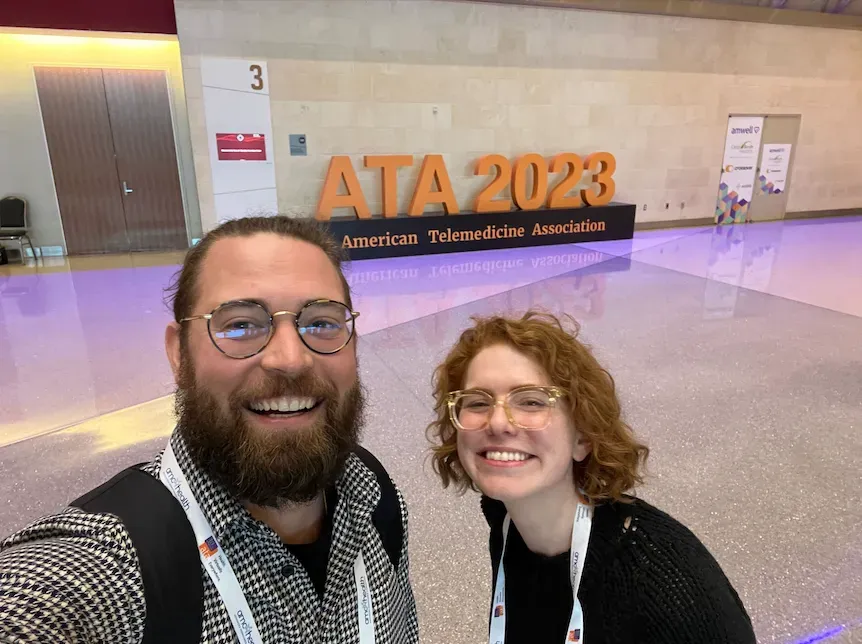Digital Health is about to be a Little Less … Digital?
What if prescription networks actually gave visibility to prescribers, pharmacies, and patients?

Original post by Emily Haugh, Director of Pharmacy Expansion at Photon
As regulatory requirements change, prescribers and pharmacists will face new burdens to make sure scripts are valid. Can prescription networks help reduce this pain and, in turn, get patients the care they need?
Otto and I recently attended the ATA annual conference, where we met a bunch of folks who are changing the landscape in digital health. It was a pretty standard healthcare conference experience apart from one huge thing: it was serendipitously scheduled one week after DEA published long-awaited draft rules on telemedicine. This surprise rule package, published on an unsuspecting Friday evening, ended up setting the tone for most of the panels and conversations that weekend. We didn’t anticipate leaving with our minds full of ideas on how Photon can help navigate upcoming challenges for patients and providers, but being solution-oriented people, we really couldn’t help ourselves.

Understanding the new rules
The DEA announcement came in anticipation of the expiration of the Federal COVID-19 Public Health Emergency (PHE) on May 11, 2023. This is significant, because during the PHE, the government temporarily waived the telemedicine restrictions in the Ryan Haight Act of 2008 (RHA). The relaxed rules allowed providers to issue controlled substance prescriptions to patients via telemedicine, even if they hadn’t performed an in-person physical exam, which was a core requirement of the 2008 ruling. This waiver meant that patients could establish remote relationships with providers and get care during the pandemic.
In practice, the waiver created an opportunity for both legacy and startup healthcare companies to begin prescribing controlled substances for indications like mental health, substance use disorder, and hormone replacement virtually over the last 3 years. During this period, patients became accustomed to easier access to care and providers were presumably able to serve more patients than they would have in their offices, which is important in an age of provider shortages and pandemic restrictions. The allowance didn’t come without risks — we saw a few companies accused of overprescribing CII stimulants like Adderall, and the devastating patient stories that resulted.
Since telemedicine has become so accepted during COVID, the DEA has proposed cutting some requirements from 2008 rules to help maintain patient access after the PHE ends. The response from the telemedicine community wasn’t exactly a jump for joy. They were expecting more permanent flexibilities after the pandemic, but I can’t help but assume that behavior from these bad actors had influence on DEA’s decision-making (multiple companies are under DEA investigation). A core component of the newly proposed rules is that patients will still need to receive an in-person physical exam in order to be issued controlled substance prescriptions via telemedicine, but may be eligible for a single 30 day script before that exam takes place. Instead of the proposed blanket requirement for in-person exams, the telemedicine community was hoping the rule would include carveouts for providers with a special registration that would show that they are meeting a need and following applicable laws.
And yes, if you haven’t noticed yet, I am a total health policy nerd.

Thinking about impact
After reading the rule and hearing from experts at ATA, I cannot help but think about the patients that will suffer due to reduced access to critical medications, and the new burdens that will be placed on already stressed prescribers and pharmacists to prove compliance with the new rule. Obligatory side note: pharmacists can serve as healthcare providers / prescribers too, and this rule doesn’t seem to acknowledge that. In the rule, they can’t prescribe via telemedicine, and it’s unclear if they’re permitted to perform the physical exams. This is disappointing, given the provider shortages we are facing all over the country. This topic may need its own future blog post.
When I think about this rule’s patient impact, I can’t help but think back on a formative experience. It’s been about eight years since I first became licensed as a pharmacist. Near the end of my training, I had two seemingly small experiences that left significant impacts on how I’ve approached patient care for my entire career. While I was still taking classes, I was lucky to be selected to be part of a small elective class on pain management and addiction treatment (another side note: this should be an absolute requirement for every healthcare provider, and probably longer than a single semester). I learned so much about pain management, opioids, and ways to help patients suffering from pain and substance use disorder. The most important takeaway was something that our professors drove home for us over and over:
We are healthcare providers, and we exist to take care of people. There are going to be times in which we have a patient in front of us and we simply cannot tell if the patient is legitimately suffering and needs a controlled substance. In those moments, we can decide to take care of someone or to turn them away, and if we’ve done everything we can to make sure it’s safe, we can choose to act like healthcare providers and not police officers.
These professors were industry experts in pain management and health law, and their teachings had a massive impact on me. This class led me to pursue a 6 week training under a renowned addiction medicine doctor and pain management pharmacist at a world-class hospital. Taking care of the patients (I still remember each one — their names and their stories) during this rotation was an absolute highlight of my career. This is saying a lot, because I’ve been lucky enough to experience the journey of being an early employee at a pharmacy startup that got acquired by one of the largest companies in the world. Yeah, it’s been a wild 8 years.
With this experience, I worry that this ruling imposes administrative requirements that are confusing and hard to validate. The prescriber and dispenser both have specific tasks they need to complete in order to get a patient their medication, but no way to see the other party fulfilled their requirements. If this surprises you, then you will really lose it when I tell you most prescribers don’t even have a way to tell if a prescription they wrote was ever filled. Photon is all over this, and I’ll write something about it soon enough.
As an example, in the new rule, prescribers need to complete a few steps in order to issue a controlled substance prescription via telemedicine. These include fulfilling the in-person exam requirement and checking prescription history in the applicable state Prescription Monitoring Program. The prescription will arrive at the pharmacy with the words “telemedicine prescription” written on its face, without any indication that a prescriber met the requirements or did their diligence. This may not sound concerning, but existing DEA law says that prescribers and pharmacists share corresponding responsibility for a prescription’s legitimacy and appropriateness. They’re both on the hook.
The fact that the prescriber and pharmacist don’t have visibility into each other’s actions on a prescription is bound to cause delays at pharmacies when processing telemedicine prescriptions. Will each prescription be subject to a game of prescriber-pharmacy phone tag while patients wait? This seems like the better way to validate requirements when compared to the alternative, via fax. On top of this, pharmacists are already reluctant, and sometimes refusing, to fill telemedicine prescriptions in the wake of the aforementioned inappropriate behavior from bad actors.
All this to say, I worry that in spending time going back and forth to validate these new requirements, healthcare providers will feel the need to act more like police officers, and patients who really need us will suffer.
Dreaming of a better way
I’m new to working with Photon, but I’ve been working in the health tech space for a decade. With this perspective, I cannot ignore my suspicions that technology can solve a lot of these problems, and potentially make things a whole lot safer and easier for everyone involved.

Photon is a prescription network, meaning we work with prescribers, patients, and pharmacists to make it easier to get prescriptions filled. We’re a young company, but we’ve been able to roll out some pretty incredible things in our first year, including functionality that can assure the pharmacist that a prescription is ready to be filled (this is important because nearly a third of prescriptions are never picked up, which is bad for patients and wastes pharmacists’ time).We’ve also built handy tools to keep patients in the loop about their prescription status at every step in the process.
I have to imagine that prescription networks, that literally exist to connect prescribers and pharmacies, can do more to to support both parties and make rules like these way easier to implement. Could networks convey that the controlled substance prescription had its requirements filled prior to issuance? Could this signal to pharmacists that a prescription is safe to fill? I must qualify this idea with the fact that Photon does not yet transmit controlled substance prescriptions, but will someday soon. This ideology does also apply to other restricted medications though, like those in FDA REMS programs, though.
I can also stretch my brain to imagine a world in which technology can take the place of the in-person exam in the DEA’s proposed process. Technology has changed a lot since these requirements were codified in 2008, and features that exist today could probably add more clinical context and validation to a script then we could back then.
The DEA’s proposed rule is open for comment through the end of March. The realist in me believes that the adopted version will be pretty close to what’s proposed today, but that doesn’t mean I am letting up on trying to make this situation better. I’m confident that Photon can make things simpler for healthcare providers, and in turn easier for patients to get the care they need. That work starts now. 💪

